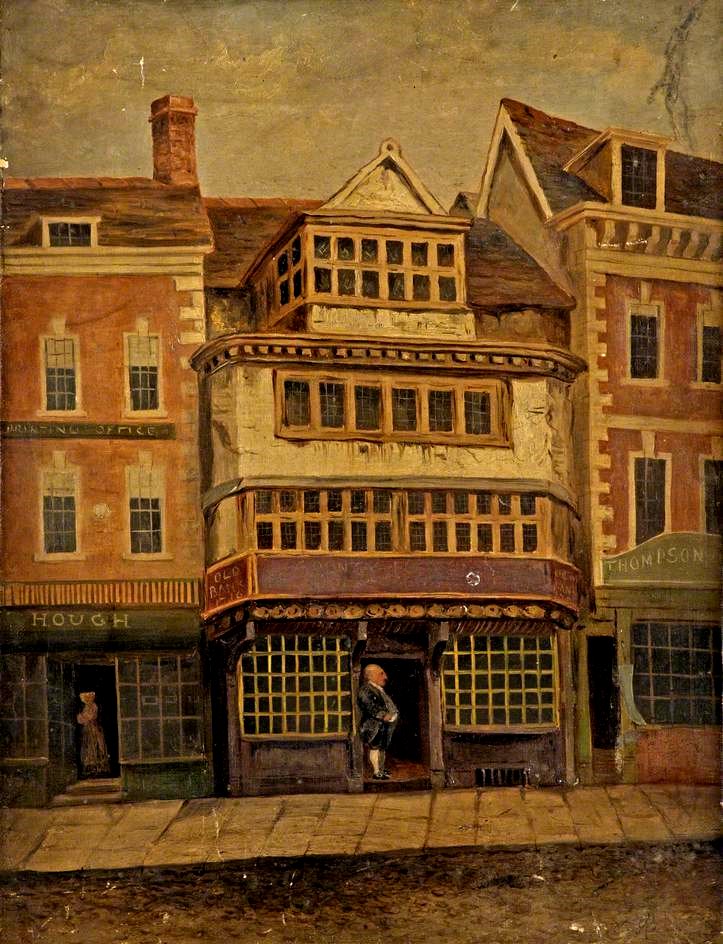Gloucester Old Bank on:
[Wikipedia]
[Google]
[Amazon]

 The Gloucester Old Bank was a British
The Gloucester Old Bank was a British
corseandstaunton.org.uk, 2005. Retrieved 1 July 2011. The bank reached its apotheosis under Jemmy, whose practice was to offer no interest on deposits of less than one year. At that time, the whole bank was believed to have consisted of just Jemmy and two clerks. Counterfeit coins were nailed to the counter as a warning to customers not to try to pass them off on the bank."Jemmy Wood's Journal"
by Irvine Grey in ''Transactions of the Bristol and Gloucestershire Archaeological Society'', Vol. 90, 1971, pp.158-177.
Banknote for Gloucester from 19th century for sale.
This is Gloucestershire, 21 September 2010. Retrieved 3 July 2011. Many provincial British towns had their own banks in the eighteenth and nineteenth centuries but their notes were usually only good in their home town.

 The Gloucester Old Bank was a British
The Gloucester Old Bank was a British bank
A bank is a financial institution that accepts deposits from the public and creates a demand deposit while simultaneously making loans. Lending activities can be directly performed by the bank or indirectly through capital markets.
Because ...
that operated between 1716 and 1838. It was founded in 1716 by James Wood.Heighway, Carolyn. ''Gloucester: a history and guide.'' Gloucester: Alan Sutton Publishing Limited, 1985, p.157. The bank was said to have been the oldest private bank in Britain, having survived the financial consequences of the Napoleonic Wars
The Napoleonic Wars (1803–1815) were a series of major global conflicts pitting the French Empire and its allies, led by Napoleon I, against a fluctuating array of European states formed into various coalitions. It produced a period of Fren ...
when many other banks went out of business. The claim is wrong as both C. Hoare & Co. and Child & Co. were founded earlier; the Gloucester Old Bank was, however, one of the oldest banks in Britain in the nineteenth century.
At some point in the nineteenth century the bank became the ''Gloucester City Old Bank''. In 1838 it was taken over by the ''County of Gloucestershire Banking Company'' which eventually became part of Lloyds Bank
Lloyds Bank plc is a British retail and commercial bank with branches across England and Wales. It has traditionally been considered one of the " Big Four" clearing banks. Lloyds Bank is the largest retail bank in Britain, and has an exte ...
.
Apotheosis
After the death of the first James Wood, the bank passed to his son Richard Wood and on his death in 1802 to James (Jemmy) Wood, who was also known as the ''Gloucester Miser''.James Wood's Time Line.corseandstaunton.org.uk, 2005. Retrieved 1 July 2011. The bank reached its apotheosis under Jemmy, whose practice was to offer no interest on deposits of less than one year. At that time, the whole bank was believed to have consisted of just Jemmy and two clerks. Counterfeit coins were nailed to the counter as a warning to customers not to try to pass them off on the bank."Jemmy Wood's Journal"
by Irvine Grey in ''Transactions of the Bristol and Gloucestershire Archaeological Society'', Vol. 90, 1971, pp.158-177.
Premises
The bank premises were a medieval timber building at 22 Westgate Street, Gloucester that remained until the nineteenth century, and consisted of a counter within a larger draper's shop. The old building once occupied by the bank was subsequently replaced with a Victorian Gothic building and more recently with a new building. It is now occupied by a McDonald's restaurant.Demise
The bank was taken over by the ''County of Gloucestershire Banking Company'' in 1838, which eventually became part of ''Lloyds Bank'' in 1897.Similar banks
The bank was just one of several small banks in Gloucester including the similarly named ''Gloucester Old Bank'', and the ''Gloucester Bank'' which was owned by John Merrol Stephens.This is Gloucestershire, 21 September 2010. Retrieved 3 July 2011.
See also
* Jemmy WoodReferences
Further reading
*Savory, Charles H. ''Life and Anecdotes of Jemmy Wood, the eccentric banker, merchant and draper, of Gloucester. Also an account of the remarkable trial with reference to his will.''. London & Cirencester: Kent & Co., 1883. {{Buildings and structures in Gloucester Defunct banks of the United Kingdom Former banknote issuers of the United Kingdom History of Gloucester Banks established in 1716 Banks disestablished in 1838 British companies established in 1716 Westgate, Gloucester 1716 establishments in England 1838 disestablishments in England British companies disestablished in 1838